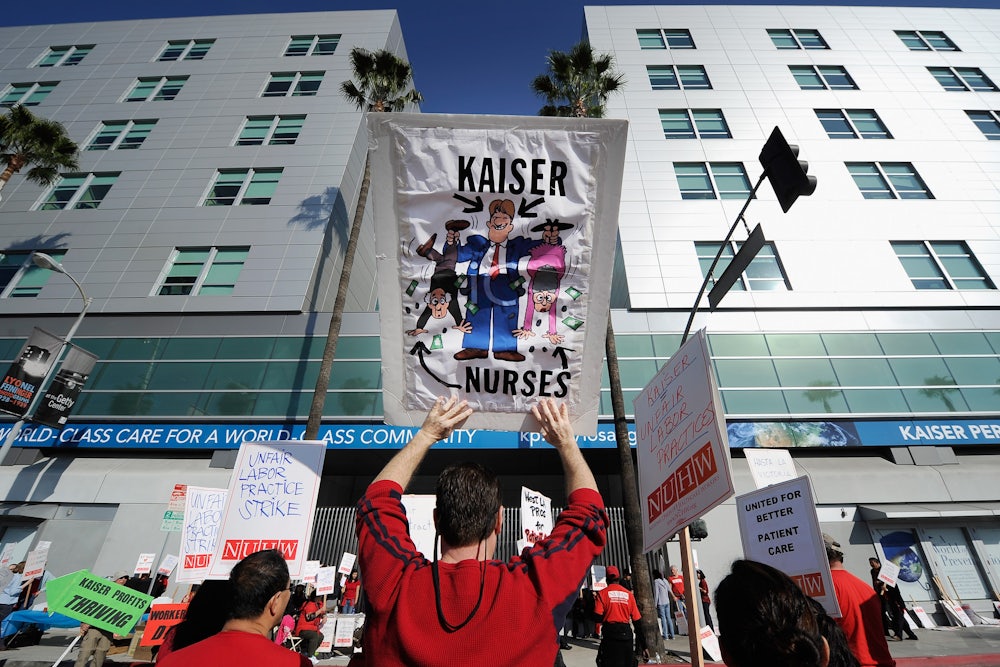On November 4, a handful of unions representing more than 30,000 Kaiser Permanente workers notified the health system of their intention to strike on November 15, a move that would be among the largest hospital workplace actions in recent memory. The strike, should workers not make a deal with their employer, would be truly massive in scope. It would affect at least 366 facilities in Southern California alone, spanning from hospitals and medical offices to clinics in Target department stores, as well as facilities in Oregon and Southern Washington.
In preparation for November 15, a staffing agency is already recruiting strike nurses in Southern California, who would be paid as much as $12,500 a week* to help Kaiser cut wages for new employees by as much as 36 percent and avoid giving its current workers more than a 1 percent raise. Kaiser has said it’s unwilling to negotiate on these numbers and that it’s taking these drastic measures on employee compensation in order to lower patients’ costs. But theoretically, based on the membership numbers provided by just one of the unions intending to strike and the listings pitched to nurses willing to cross a picket line, replacing 19,000 striking nurses could cost $237 million a week. If you add up every single worker who has threatened to strike—including pharmacists, occupational therapists, optometrists, and others—the weekly cost of the striking hospital system could exceed $250 million (provided current staffing levels are retained). “Clearly the company is being disingenuous in their desire to cut costs,” said Jane Carter, a labor economist and a member of the bargaining team for the United Nurses Association of California/Union of Health Care Professionals.
If they were to walk off the job, Kaiser employees would join tens of thousands of Americans who have taken part in nearly 170 strikes this year, most of them in industries deemed essential during the pandemic, who labored under threat of infection and exhaustion to keep businesses afloat. The Kaiser dispute centers on the issue of two-tier pay, a system deployed in the past by struggling companies under extreme duress, which is now increasingly being proposed by profitable entities. For every measure taken during a crisis, there is, apparently, an opportunity to make the crisis the norm.
Essentially, the two-tier system proposed by Kaiser imposes different wages for the exact same work. A practice common through the 1980s, it was most famously used by car manufacturers in 2007, during the industry’s near-collapse. But even Fiat’s CEOs called it “unsustainable,” considering how obviously it fomented tension between employees and eviscerated morale, which isn’t to mention the general cynicism of reducing pay for new employees based on the idea that a company can’t sustain its previous estimation of a living wage.
How interesting, then, that John Deere workers are striking over two-tier pay when the company hit record profits and the CEO made $15.6 million last year and that Kellogg’s workers are also striking, in part to turn over a system that has new hires receiving limited benefits and making $10 less than their counterparts every hour. Kellogg’s, incidentally, saw its profits rise more than a quarter over the course of 2020. Its CEO received more than $11 million in compensation during the same year. According to Kaiser’s most recent Securities and Exchange Commission filing, which, granted, is from the distant past of 2019, more than 30 Kaiser executives made over $1 million a year. The plan Kaiser is proposing would cut pay for new health care workers between 26 and 39 percent, at a moment when almost every executive is quite publicly panicking over not being able to find enough nurses to make their businesses run. For the most part, Kaiser has framed this issue around the problems of equity in access to health care: “If we continue to increase costs so high about the marketplace, we will become unaffordable and lose members,” a representative from the company’s H.R. department has said. “And the fact is: Health care is increasingly unaffordable, and escalating wages are half the cost of health care.”
Through the grimmest months of the pandemic, a flurry of stories described troubling practices within Kaiser facilities. In one Fresno hospital, health care workers cobbled together their own respirators with sheets of plastic and electrical tape and blamed the hospital for the death of a nurse who they said hadn’t been provided with adequate protection. After the state of California granted a staffing waiver to reduce patient ratios in December 2020, staff described patients crammed so tightly into single rooms, a worker had to climb over a bed to treat someone who was ill. As of this year, the system had received more citations from California’s worker-safety agency than any other in the state, generating almost $500,000 in fines. It is also, as of July, the subject of six complaints alleging it defrauded the government through the intentional miscoding of Medicare patients.
Through all this, Kaiser, like many of the other massive conglomerates that have increasingly come to dominate the industry, reported steep incomes as the pandemic raged on. Though the system is a nonprofit, it is among the largest in the country, operating 700 medical offices and nearly 40 hospitals in nine states. Earlier this year, following scrutiny over Cares Act payments, the nonprofit returned $500 million of the grants it had received and still managed to report $6.4 billion in income in 2020. But the UNAC/UHCP’s members said the system is forecasting a dire future if it continues to pay all staff members the wages that were paid as they treated Covid-19 patients in crowded clinics without enough equipment to keep themselves safe.
So far, the two-tier payment system Kaiser is proposing has baffled the members of the union, who only see the health system growing. Carter says she’d be happy to explore other ways to cut costs, but the wage system would likely cost the system more in training and turnover in the long run, which isn’t to mention the back-of-the-napkin math about how much it would cost to hire an army of scabs. “I’m a labor economist,” she said, “and I don’t understand how this company can legit put forward this proposal.”
* This article originally misstated the pay rate offered by the strike staffing agency.








